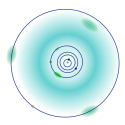| Discovery[1] | |
|---|---|
| Discovered by | Pan-STARRS 2 |
| Discovery site | Haleakala Observatory |
| Discovery date | 18 March 2023 |
| Designations | |
Martian L4  | |
| Orbital characteristics[2] | |
| Epoch 13 September 2023 (JD 2460200.5) | |
| Uncertainty parameter 0 | |
| Observation arc | 5503 days (15.07 yr) |
| Aphelion | 1.764696353 AU (263.9948168 Gm) |
| Perihelion | 1.2828435 AU (191.91066 Gm) |
| 1.523769939 AU (227.9527383 Gm) | |
| Eccentricity | 0.15811207 |
| 1.88099354 yr (687.032891 d) | |
| 26.03608° | |
| 0° 31m 26.373s / day | |
| Inclination | 13.272714° |
| 21.84773° | |
| 245.29506° | |
| Earth MOID | 0.331663 AU (49.6161 Gm) |
| Jupiter MOID | 3.31104 AU (495.325 Gm) |
| Physical characteristics | |
| Dimensions | ~320 m[3] |
| 0.047 | |
| X[3] | |
| 21.6[2] | |
2023 FW14 is a small asteroid orbiting near the L4 point of Mars (60 degrees ahead of Mars on its orbit). As of March 2024, it is the second known asteroid to orbit the leading L4 point of Mars together with (121514) 1999 UJ7, although at least 15 other asteroids orbit Mars's trailing L5 point, including 5261 Eureka, (101429) 1998 VF31, and 2007 NS2.[3] Not only does 2023 FW14 orbit on the other side of Mars from other similar asteroids, its spectrum is different as well, but close to that of (121514) 1999 UJ7.[3]